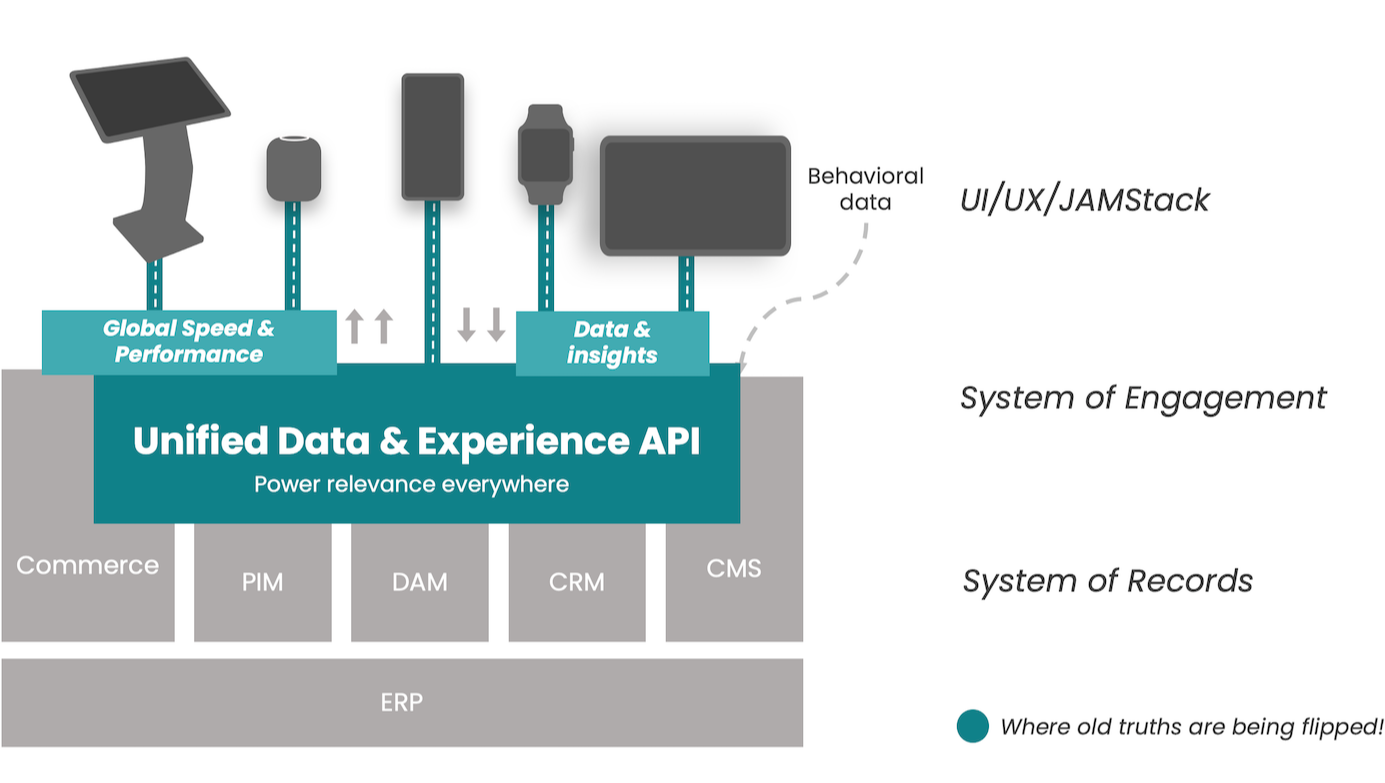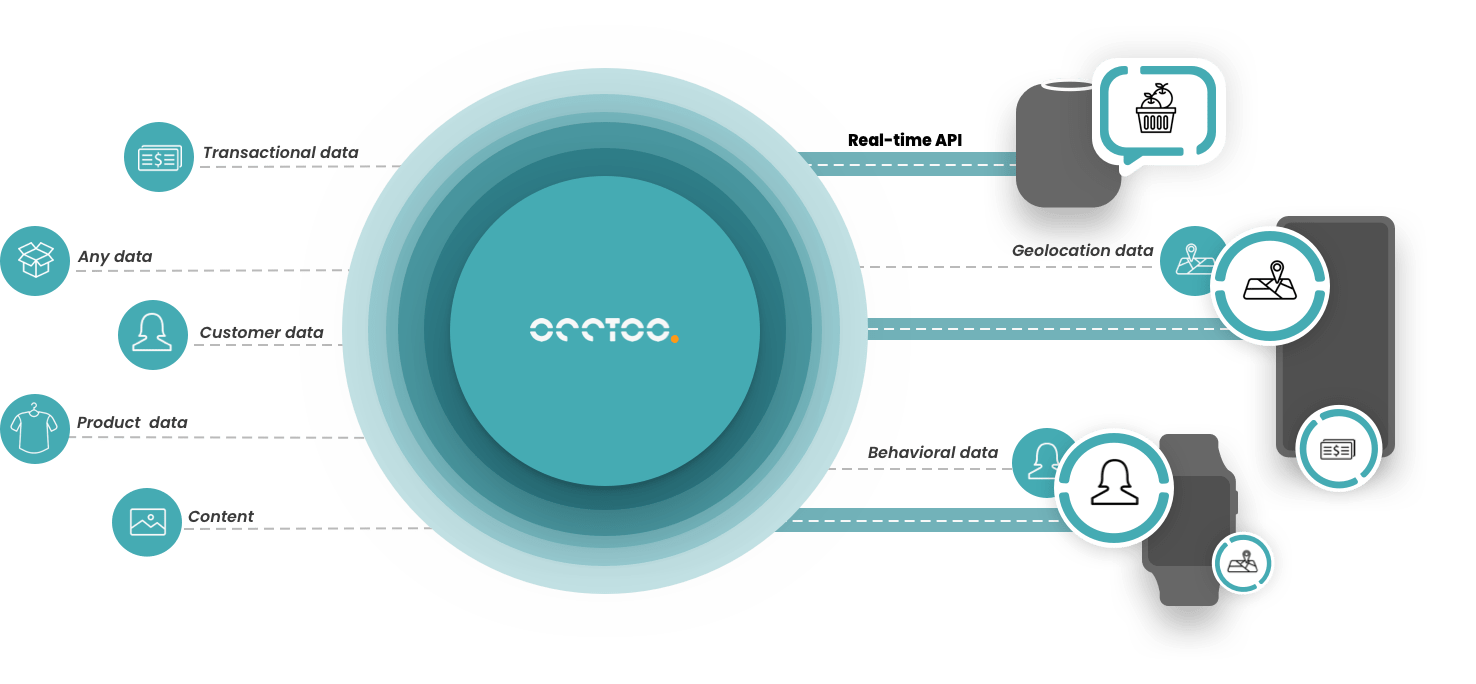Yesterday you needed a mobile app, today you need a personalized website, and customers have an increased demand for self-service screens. You need to set yourself up for quick adaptation to new market demands so you can build experiences both at speed and scale to be ready for whatever the world throws at you. The answer to doing that is to have a Headless approach with Experience APIs.
What is an Experience API?
An Experience API is a purpose-built API created for a specific context or channel. It turns your enterprise data from your system of records (PIM, CRM, ERP, DAM etc) into experience data: this is a combination of data to match the exact needs to execute a specific digital customer experience initiative. The Experience API then makes your data instantly available to your frontend of choice, enabling you to have a decoupled frontend and backend (data).
Let me give you an example! Let’s say you want to create a new mobile application to support your in-store staff. In the ideation phase you identify that you need product data, customer data, transactional data and geo-location data to build this channel specific experience. With an Experience API you can make these specific data assets instantly available for a developer to quickly build your frontend experience.
The next time you want to launch a new initiative, you will create a new Experience API with the data assets necessary to build that specific experience for that specific channel and frontend. It may be a new website, an in-store screen or a billboard on Times Square. That’s up to you!
These types of APIs differ significantly from the traditional API with one version that makes all data from a given system available. This will restrain innovation and capability to what that API is able to do. With this approach you also need to constantly build everything from the ground up when you have a new innovation or experience in mind. This is not only costly, but it takes too much time. Time that you don’t have.

An Experience API is created to make just the right dataset available in any frontend in milliseconds. Think about it as a Slack channel (by the way, Occtoo's Experience APIs are created just as easy as a Slack channel). Just as you have vibrant conversations in each unique Slack channel, you will have unique APIs fuelling your different channels with data from one unified experience data source. They are also automatically looping data back in real-time with insights, constantly gaining information from each customer interaction. Over time, this provides you with a real unified data powerhouse to optimize each new customer interaction based on previous behaviour. All of these insights can then be used across channels and screens to build new and more relevant unified customer experiences.
See our CX Technologist, Larre Ländin demonstrate how you can create an Experience APIs with Occtoo here
Experience APIs are fast, they are agile, and they truly enhance the customer experience!
 With Experience APIs you can quickly transform your enterprise data into experience data and make it available for a specific channel or project. The Experience API will fuel the frontend with data in milliseconds and loop data back from each customer interaction.
With Experience APIs you can quickly transform your enterprise data into experience data and make it available for a specific channel or project. The Experience API will fuel the frontend with data in milliseconds and loop data back from each customer interaction.
Be 4x faster to market - Real world examples of success
Our customers say this approach is 4x faster to market. Imagine launching a new experience in 6 weeks instead of the normal 6 months. This is the average time it takes to launch a digital experience with a traditional approach according to research from the MACH Alliance. 6 months! The only fast thing in this equation is the death of business, driven by time-consuming and expensive integrations on legacy technology, so let’s leave that to the past 😅
Someone that has succeeded with this approach is global luxury brand, Cartier. Using a Headless approach with Experience APIs they have managed to quickly build a stellar app universe with several new apps supporting their team and customers across the world both online and in their 300 retail boutiques. They have also managed to do this without ripping and replacing in their existing tech stack since the Occtoo Experience APIs just sits on top of those systems, making their previous investments in backend systems (CRM, PIM, ERP etc) even more valuable.
Occtoo Experience APIs will enable you to:
- Serve experiences on a global scale in milliseconds in any frontend
- Re-use and re-purpose experience data across channels and screens
- Quickly go from idea-to-deployment and launch new digital experiences and apps in lightning speed
A Headless approach with Experience APIs is the answer to get the capabilities to think big, start small and scale fast. With Occtoo Experience APIs you will become the champion of building digital experiences with speed and at scale, being ready for whenever the world throws you a punch both from left and right.
About Occtoo
Occtoo is an Experience Data Platform that fast forwards how digital officers, marketers and developers create relevant customer experiences everywhere. Unify all your experience data (transactional data, product data, customer data, content etc) with ease and access it from one single place. Make unique combinations of customer, context and content data and create an Experience API with a click to make the data available in real-time in any frontend, channel or device. 

